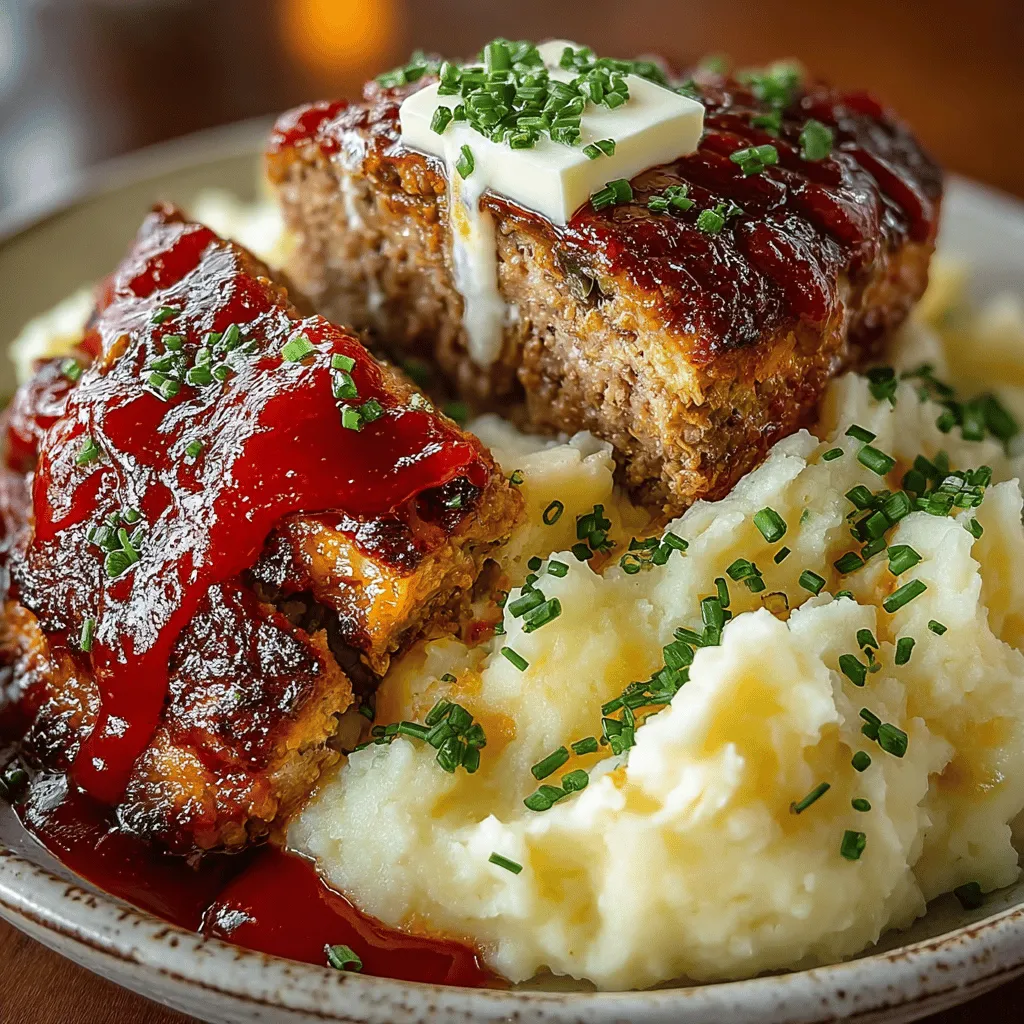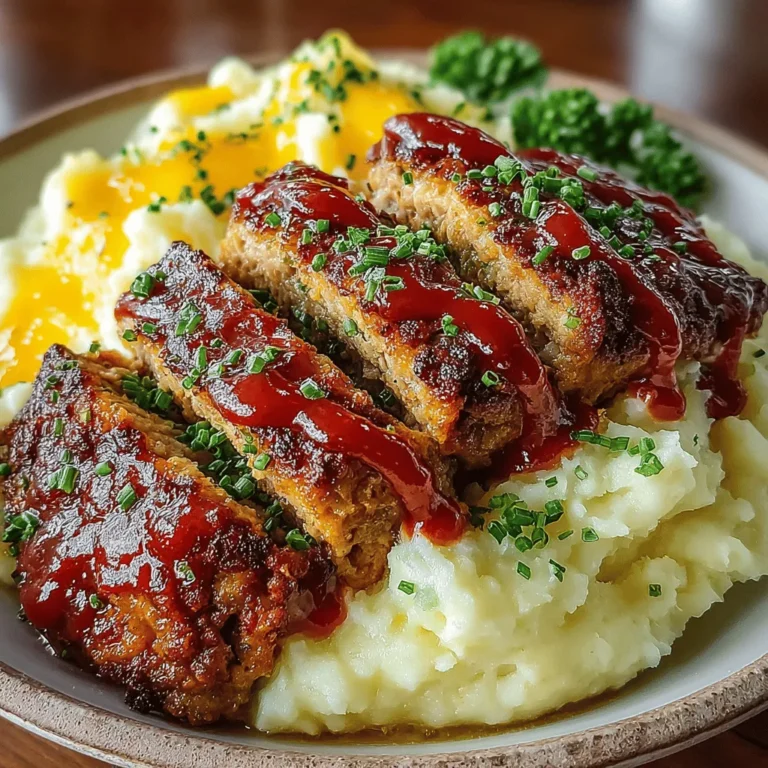Introduction
Comfort food has a unique power to evoke nostalgia and warmth, often transporting us back to cherished moments shared with family and friends. The essence of comfort food lies not just in its flavor but in the memories and emotions it cultivates. Among the many dishes that embody this genre, meatloaf stands out as a quintessential staple. Paired with creamy mashed potatoes, this meal represents the heart of home cooking, offering both sustenance and satisfaction.
In this article, we will delve into the recipe for Comforting Classic Meatloaf & Creamy Mashed Potatoes, guiding you through the step-by-step process to create this satisfying dish. You can expect detailed instructions, insights into the ingredients that make this meal special, and serving suggestions that will elevate your dining experience. Whether you are revisiting childhood favorites or discovering this dish for the first time, you are in for a delightful culinary journey.
The Heart of Comfort Food: Meatloaf
Historical Context: The Origins of Meatloaf in American Cuisine
Meatloaf is a dish with roots that trace back to various culinary traditions, but it became a beloved American classic in the early 20th century. The industrialization of food production and the rise of convenience cooking played a significant role in its popularity. During the Great Depression, meatloaf emerged as an economical option, allowing families to stretch limited resources by mixing ground meat with fillers like breadcrumbs and vegetables. This adaptation made it a practical choice for households striving to provide nourishing meals on a budget.
As the years progressed, meatloaf evolved from a humble dish to a comfort-food icon, often appearing on dinner tables across the United States. Its ability to adapt to personal tastes and family traditions has solidified its place in American cuisine.
Variations Around the World
While meatloaf is quintessentially American, variations of this dish exist in many cultures. For instance, the German “Hackbraten” is often flavored with onions and spices, while the Italian “Polpettone” may include herbs, cheese, and even a savory filling. In Latin America, meatloaf might be enriched with spices and served with rice and beans. These global interpretations highlight the versatility of meatloaf, showcasing how different ingredients and cooking techniques can transform a simple recipe into something unique and flavorful.
Why Meatloaf Remains a Family Favorite
The enduring popularity of meatloaf can be attributed to its remarkable flexibility and comforting flavor. Families can customize it according to personal preferences, making it easy to incorporate different meats, spices, and add-ins. This adaptability not only caters to various taste buds but also encourages creativity in the kitchen.
Moreover, meatloaf is often associated with family gatherings and special occasions, creating a sense of nostalgia for many. The aroma of meatloaf baking in the oven can evoke memories of home-cooked meals and the warmth of shared moments with loved ones. This emotional connection is what makes meatloaf a timeless dish that continues to grace dinner tables across generations.
Ingredients Breakdown for Meatloaf
To craft a delicious meatloaf, it is essential to choose high-quality ingredients that contribute to the overall flavor and texture of the dish. Here’s a breakdown of the key components:
Ground Beef
One of the most crucial elements of meatloaf is the choice of ground beef. A blend that is 80% lean and 20% fat is recommended for optimal flavor and moisture. The fat content ensures that the meatloaf remains juicy and tender during cooking, while the leaner portions provide structure. This balance is key to achieving the perfect meatloaf that is neither dry nor overly greasy.
Italian Seasoned Breadcrumbs
Italian seasoned breadcrumbs play a significant role in enhancing both the flavor and moisture of the meatloaf. These breadcrumbs are typically infused with a mix of herbs and spices, which not only contribute depth but also help bind the ingredients together. The use of seasoned breadcrumbs means less additional seasoning is required, simplifying the cooking process while ensuring a flavorful outcome.
Aromatics
Aromatic ingredients such as onion and garlic are essential for deepening the flavor profile of meatloaf. Finely chopped onion adds sweetness and moisture, while garlic imparts a robust, savory note. Sautéing these aromatics before mixing them into the meatloaf can further enhance their flavors, resulting in a more complex and satisfying dish.
Worcestershire Sauce and Ketchup
Both Worcestershire sauce and ketchup are integral to the taste and moisture of meatloaf. Worcestershire sauce brings a tangy depth, while ketchup adds sweetness and a touch of acidity. Together, they help to create a well-rounded flavor that elevates the dish. Additionally, these sauces contribute to the meatloaf’s overall moisture, preventing it from becoming dry during cooking.
Spices
Seasoning is vital in bringing out the flavors of the ingredients in meatloaf. A simple combination of salt, pepper, and thyme is often sufficient to enhance the overall taste. Salt boosts the natural flavors, pepper adds a touch of heat, and thyme introduces an earthy note that complements the other ingredients beautifully.
Crafting the Perfect Meatloaf
Prepping the Oven
Before diving into the mixing process, it’s important to prepare your oven by preheating it to the recommended temperature. Preheating ensures even cooking and helps achieve a nice crust on the outside of the meatloaf while keeping the inside moist and tender. A well-preheated oven is an essential step in achieving that perfect balance of textures.
Mixing Techniques
When it comes to mixing the ingredients for meatloaf, technique is key. Overmixing can lead to a dense and tough texture, so it’s important to combine the ingredients gently. Start by mixing the dry ingredients separately before adding them to the meat. Use your hands or a large wooden spoon to fold the mixture until just combined. This method helps maintain tenderness and ensures a light, flavorful meatloaf.
As we move forward, we will explore additional steps and serving suggestions that will elevate this comforting classic into a meal that your family will cherish for years to come. Stay tuned for the next part, where we will dive deeper into the preparation and cooking process for both the meatloaf and the creamy mashed potatoes.

Shaping and Baking
When it comes to shaping your meatloaf, you have a few options. The classic loaf shape is a popular choice, but you can also opt for freeform shapes for a rustic look. To achieve the perfect crust, start by shaping the meat mixture into a loaf that’s approximately 8 to 10 inches long and 4 to 5 inches wide. This size ensures even cooking and allows for a delightful crust to form.
To help your meatloaf develop a rich, flavorful crust, consider the following tips:
– Use a Baking Sheet: Instead of a loaf pan, shape your meatloaf on a lined baking sheet. This allows the sides to crisp up and promotes even cooking.
– Topping with Glaze: Brush a mixture of ketchup and brown sugar or a homemade barbecue sauce on top of your meatloaf before baking. This adds flavor and aids in forming a caramelized crust.
– Avoid Overpacking: When shaping the meatloaf, avoid overpacking the meat mixture. A loosely formed loaf allows for better airflow and even cooking, resulting in a tender interior.
Cooking Time and Temperature
Monitoring the internal temperature of your meatloaf is critical for achieving a perfectly cooked dish. The USDA recommends cooking ground beef to an internal temperature of 160°F (71°C). Use an instant-read thermometer to check the temperature at the thickest part of the meatloaf. This ensures that your meatloaf is safe to eat while still maintaining its juicy texture.
Baking typically takes about 1 hour at 350°F (175°C). However, baking times can vary based on the size of your meatloaf and your oven’s accuracy. A key tip is to begin checking the internal temperature around the 50-minute mark to avoid overcooking. Letting it rest for at least 10 minutes after removing it from the oven allows the juices to redistribute, resulting in a moist and flavorful meatloaf.
The Creamy Companion: Mashed Potatoes
Choosing the Right Potatoes
For creamy mashed potatoes, Yukon Gold potatoes are the preferred choice among chefs and home cooks alike. Their naturally buttery flavor and creamy texture lend themselves perfectly to mashing. Yukon Golds have a medium starch content, which helps create a smooth consistency without becoming gummy.
If you’d like to experiment, Russet potatoes can also be used, but they tend to be more starchy and may require more butter and cream to achieve that rich, creamy texture.
The Science of Boiling
Achieving fork-tender potatoes is essential when making mashed potatoes. Start by washing your Yukon Gold potatoes thoroughly. Cut them into even-sized chunks, about 1 to 2 inches, to promote even cooking. Place the potatoes in a pot of cold water and bring the water to a boil. Adding a generous pinch of salt to the water enhances the flavor of the potatoes as they cook.
Here are some boiling tips to ensure perfect results:
– Start with Cold Water: Starting the potatoes in cold water ensures they cook evenly. If you add them to boiling water, the outer layer will cook faster than the inside, resulting in uneven texture.
– Boil Gently: Once boiling, reduce the heat to maintain a gentle simmer. This prevents the potatoes from breaking apart and becoming waterlogged.
– Check for Doneness: After about 15 to 20 minutes, test the potatoes with a fork. They should be tender and easily pierced. If they are still firm, continue boiling for an additional 5 minutes.
Achieving Creaminess
The secret to achieving that signature creamy texture in mashed potatoes lies in the combination of butter and heavy cream. Once your potatoes are cooked and drained, return them to the pot over low heat. This allows any excess moisture to evaporate before mashing.
Here are tips for achieving the perfect creaminess:
– Butter First: Add your butter to the warm potatoes first, allowing it to melt and coat the potatoes before adding cream. This enhances the overall flavor and creaminess.
– Heavy Cream vs. Milk: For an ultra-creamy texture, opt for heavy cream. If you’re looking for a lighter option, whole milk or half-and-half can also work well, but may not provide the same richness.
– Adjust to Taste: Start with a small amount of cream, gradually adding more until you reach your desired consistency. Each potato can absorb liquid differently, so adjust accordingly.
Seasoning Tips
Balancing salt and pepper is crucial for optimal flavor in your mashed potatoes. Always taste as you go. Start with about a teaspoon of salt for every pound of potatoes, and adjust according to your preference. Freshly ground black pepper adds a subtle heat, but be cautious not to overpower the dish.
Step-by-Step Instructions for Mashed Potatoes
1. Boiling Process:
– After washing and peeling your Yukon Gold potatoes, cut them into uniform chunks.
– Place the potato chunks in a large pot and cover with cold water. Add a generous pinch of salt.
– Bring the water to a boil over high heat, then reduce to a gentle simmer.
– Cook the potatoes until fork-tender, about 15 to 20 minutes.
2. Mashing Techniques:
– Once cooked, drain the potatoes in a colander and return them to the pot over low heat to dry out for a minute.
– For mashing, you can use a traditional potato masher for a rustic texture, or a hand mixer for an ultra-smooth consistency. If using a hand mixer, be careful not to overmix, as this can make the potatoes gummy.
3. Final Touches:
– Incorporate the butter first, allowing it to melt into the warm potatoes.
– Gradually add heavy cream until you reach your desired creaminess.
– Season with salt and freshly ground black pepper to taste, adjusting as necessary.
Serving Suggestions and Presentation
Plating Techniques
Presentation can elevate your comforting meatloaf and mashed potatoes to a new level. Start by slicing your meatloaf into thick, even slices, and place them on a warm plate. Place a generous scoop of creamy mashed potatoes next to the meatloaf, allowing the two to overlap slightly for a homestyle appearance.
Garnishing Ideas
Add vibrant garnishes to enhance the visual appeal and flavor of your dish. Chopped fresh chives or parsley sprinkled on top of the mashed potatoes brings color and freshness. For those who enjoy a tangy contrast, a drizzle of ketchup or barbecue sauce over the meatloaf adds both flavor and a pop of color.
Pairing Recommendations
To complement your classic meatloaf and creamy mashed potatoes, consider serving a side of steamed green beans or sautéed broccoli. These vegetables add a fresh crunch to your plate. For beverages, a hearty red wine, like a Cabernet Sauvignon, pairs beautifully with the rich flavors of the meatloaf, while a light-bodied white, such as Chardonnay, can also work if you prefer something lighter.
Conclusion
This comforting classic meatloaf and creamy mashed potatoes recipe captures the essence of homestyle cooking, bringing warmth and nostalgia to family meals. The tender, flavorful meatloaf paired with buttery, smooth mashed potatoes creates a satisfying dish that is perfect for any occasion, whether it be a casual weeknight dinner or a festive holiday gathering.
As you explore variations, consider experimenting with different seasonings or adding vegetables to the meatloaf mixture for added nutrition. The joy of cooking and sharing meals with loved ones is immeasurable, so gather your family around the table and enjoy the delightful flavors of this classic dish. Remember, the best recipes are those that allow you to make them your own, so feel free to put your personal spin on this comforting favorite!


